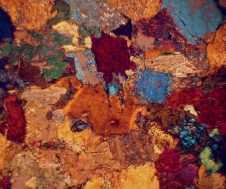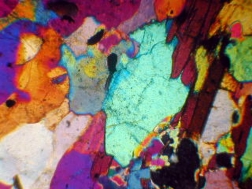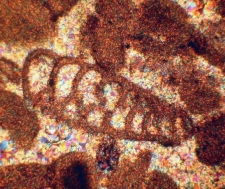 |
 |
 |
|
| Plutonit | Plutonit | Sediment |
Especially in the North
German Plain there are numerous different rocks that have been transported as
bedload by the glaciers during ice age from Scandinavia to northern Germany
and can now be easily collected in gravel pits.
Crack off thin splinters
about 2 cm long and abrade them on one side with abracives of different grain
size on a wet glass plate. It is not necessary to polish them properly. After
that cement these splinters with hot Canada balsam on a slide and abrase them
from the other side down to about 20 um. After mounting them with Canada balsam
examine these colorless sections in polarized light: the individual crystals
show bright interference colors.
With a little practice it is possible to determine the various rock-forming minerals, but such sections show much more: we can deduct the genesis of the rock under inspection.
We give you three simple examples: The first two images show plutonic rocks, that means rock that has crystallized from a liquid melt, and therefore consists entirely of crystals. The third image displays a sedimentary rock, i.e. a rock which has gradually formed from lithified marine sediments. We can clearly detect a mineralized microfossil, while the colored grains of sediment particles between the dark ones are developing into new mineral crystals. A few hundred million years later the microfossils are gone or can only be identified as so-called "ghost structures".
Copyright: webmaster@mikrohamburg.de